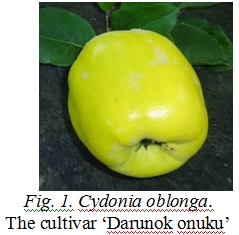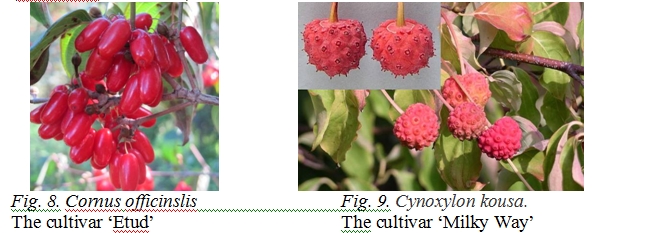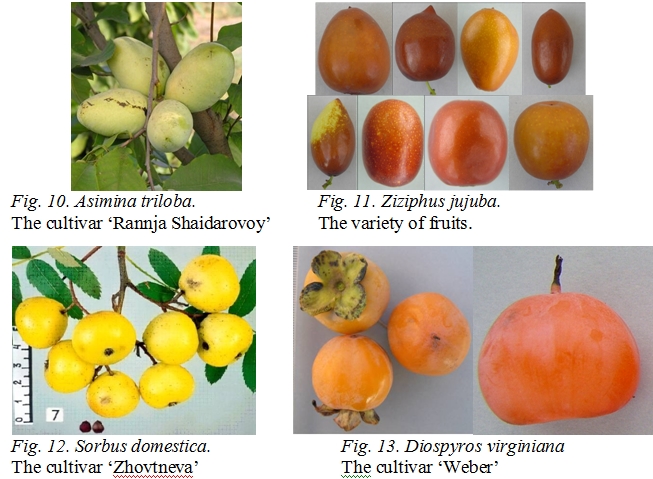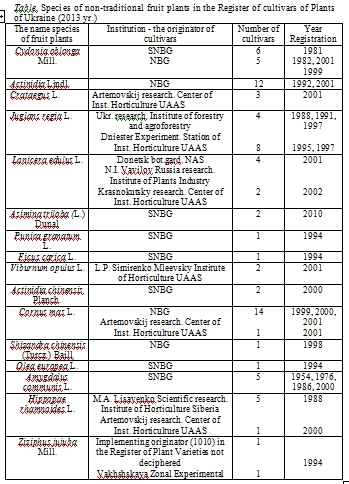НЕТРАДИЦИОННЫЕ ПЛОДОВЫЕ РАСТЕНИЯ В УКРАИНЕ: СОСТОЯНИЕ И ПЕРСПЕКТИВЫ КУЛЬТИВИРОВАНИЯ Клименко С.В., Григорьева О.В.
:: Обсуждения, беседы, обмен опытом :: Обсуждение присланных на конференцию "Новые сорта садовых культур: их достоинства и экономическая эффективность возделывания" материалов
Страница 1 из 1
 НЕТРАДИЦИОННЫЕ ПЛОДОВЫЕ РАСТЕНИЯ В УКРАИНЕ: СОСТОЯНИЕ И ПЕРСПЕКТИВЫ КУЛЬТИВИРОВАНИЯ Клименко С.В., Григорьева О.В.
НЕТРАДИЦИОННЫЕ ПЛОДОВЫЕ РАСТЕНИЯ В УКРАИНЕ: СОСТОЯНИЕ И ПЕРСПЕКТИВЫ КУЛЬТИВИРОВАНИЯ Клименко С.В., Григорьева О.В.
UDK 634.4:[581.522.4±581.95]:631.527
NON-TRADINIONAL HORTICULTURAL PLANTS IN UKRAINE: THE STATE AND THE PERSPECTIVES OF CULTIVATION
KLYMENKO S.V. – Doctor of biology, professor,
GRYGORIEVA O.V. – PhD in biology, senior scient. research.
M.M. Gryshko National Botanical Garden of the National Academy of Sciences of Ukraine, Kyiv, Ukraine, e-mail: cornusklymenko@mail.ru
НЕТРАДИЦИОННЫЕ ПЛОДОВЫЕ РАСТЕНИЯ В УКРАИНЕ: СОСТОЯНИЕ И ПЕРСПЕКТИВЫ КУЛЬТИВИРОВАНИЯ
Клименко С.В. – д.б.н., профессор, Григорьева О.В. – к.б.н., с.н.с.
Национальный ботанический сад им. Н.Н. Гришко Национальной академии наук Украины, г. Киев, Украина, e-mail: cornusklymenko@mail.ru
Resume
The results of long-term work on introduction and selection of nontraditional fruit plants in Ukraine are presented. Rich genetic pool of nontraditional fruit plants has been accumulated in the Botanical Gardens of Ukraine.
The significance of the introduction populations for enlargement of the diversity and applied selection is presented. The role of cultivar as the lasting part of introduction and selection is described and also the achievements within selection of nontraditional fruit plants in Ukraine. Perspective cultivars of these species have been incorporated in the ”Register of cultivars of plants of Ukraine”.
Резюме
Представлены результаты многолетних исследований по интродукции и селекции нетрадиционных плодовых растений. Богатые генофонды нетрадиционных плодовых растений собраны в ботанических садах Украины.
Показано значение интродукционных популяций для сохранения биоразнообразия и использования в селекции. Освещена роль сорта, как логического продолжения интродукции и достижения в селекции нетрадиционных плодовых растений в Украине. Перспективные сорта этих видов внесены в «Реестр сортов растений Украины».
Introduction
850 types of fruit and berry plants are cultivated in the world, in Ukraine were introducted about 400 species. From 50 genus only for three monotype species – Cydonia Mill., Mespilus L. and Pseudocydonia C.K. Schneid – specific reserve appeared by exhausted one, while for most species he remained considerable.
Quite recently the such growing wild plants, as kiwis, sea-berry, honeysuckle, are entered in a culture, getting wide distribution for a few ten years. Such species, as mountain-ash, highbush cranberry, hawthorn, cornelian cherry are used by a man from time immemorial, however lost the sorts selected by a folk selection are, at other sorts were not and they were used at the level of natural standards and only in the last decades with them selection work is conducted.
In nature there is yet the large variety of fruit plants, which represent a large value as donors of high quality of garden-stuffs and productivity, stability to the unfavorable external conditions (Rop et al., 2010).
Materials and methods
The objects of research – the species of non-traditional fruit plants. Subject of research – an analysis of the species composition of native and introduced non-traditional fruit plants and their cultivars in the Register of Plant Varieties of Ukraine are entered (Державний…, 2007).
We used the methods of scientific informatics, which allowed to analyze the species composition of nontraditional introduced and cultivated fruit plants in Ukraine. The basic method of working with non-traditional plants in the botanical gardens and experimental breeding stations were analytical and synthetic breeding. The basic method of synthetic selection is a hybridization, which remains the most effective way to create new cultivars of plants with a modification of their heredity. Along with traditional breeding methods are now widely used mathematical methods and computer equipment (Щеглов, 1999).
Results and discussion
The industrial gardening of Ukraine is represented by the limited number of species of fruit plants: apple-tree, pear, cherry, plum, cherry-plum, in a less measure is apricot, merry, peach.
Last years in gardening of our country, as well as other countries, new fruit and berry plants till recently meeting only in nature are entered. The non-traditional fruit plants differ by high maintenance of valuable biological active substances and have the important economic value.
Works of the State Nykytskyj botanical gardens (SNBG) are well-known, now is the National Scientific Center – Ukrainian Academy of Аgrarian Sciences on the selection of cherry-plum (Prunus cerasifera), quince (Cydonia oblonga), almond (Amygdalus communis), fig (Ficus carica), unaby (Ziziphus jujuba), pomegranate (Punica granatum), olive (Olea europaea), persimmon (Diospyros kaki) (Klymenko et. al., 2010).
Works on introduction and selection of new for a culture in Ukraine species are conducted the M.M. Grishko National botanical gardens (NBG) in Kyiv, Donetsk and Kryvorozhskiy botanical gardens of NAN of Ukraine, dendroparks NAN of Ukraine – are ”Sofyevka” (Uman) and ”Alexandrija” (White Church). There are such species: honeysuckle of edible (Lonicera edulus), provincial person multiflorous (Elaeagnus multiflora), highbush cranberry (Viburnum opulus), mulberry white (Morus alba), sea-buckthorn (Hippophae rhamnoides), types of hawthorn (Crataegus), bear nut (Corylus colurna), in Register of sorts of plants of Ukraine (2013) 6 cultivars of quince are borne, 3 are cherry-plums, 2 are kiwis, 20 – peach, 1 – nektaryn, 1 is grenade, 1 is olive, 1 – fig, 1 is persimmon of the SNBG selection; 1 cultivar of cherry-plum, 1 – Schisandra vine, 4 – flowering quince, 5 – quince, 12 – kiwis, 14 – cornelian cherry of the NBG selection; 3 cultivars of mulberry, 4 – honeysuckle of selection of the Donetsk botanical garden of NAN of Ukraine (Tabl.).
By basis for creation of cultivars served rich genetic fund of fruit plants, collected in collections of botanical gardens of Ukraine.
Collection of fruit plants of the NBG is represented more than by 120 species and forms of growing wild and 2000 cultivars of cultural plants.
Work on the introduction and selection of fruit plants in the NBG can be represented by such stages, which completed by creation of new cultivars:
Stage I – 1945–1960 yrs: 1. Genus Persica (P.vulgaris, P.Davidiana etc.).2. Genus Armeniaca (A.vulgaris, A.manshurica etc.).3. Genus Prunus (P.cerasifera, P.spinosa etc.).4. Genus Crataegus (C.monogyna, C.submollis, C.cruss-galli, C.arnoldiana etc.). 5. Genus Malus (M.domestica – local cultivars, M.floribunda, M.baccata, M.sargentii, M.Niedzwetzkiana etc.). 6. Genus Pyrus (P.communis, P.elaeagrifolia, P.betulifolia etc.). 7. Genus Sorbus (S.aucuparia, the cultivars Likernaja, Granatnaja, Titan, Sorbinka, S.domestica, S.fenica etc.). 8. Genus Cerasus (C.vulgaris, C.avium, C.tomentosa). 9. Genus Actinidia (A.arguta, A.kolomikta, A.chinensis etc.). 10. Genus Juglans (J.regia, J.manshurica, J.cinerea etc.). 11. Genus Vitis (V. vinifera).
Stage II – 1960–1980 yrs: 1. Species Aronia melanocarpa. 2. Species Cornus mas. 3. Species Cydonia oblonga. 4. Species Hyppophae rhamnoides. 5. Species Shizandra chinensis. 6. Species Shepherdia argentea. 7. Species Viburnum opulus. 8. Genus Amelanchier (A.rotundifolia, A.canadensis, A.spicata). 9. Genus Morus (M.nigra, M.alba). 10. Genus Chaenomeles (Ch.japonica, Ch. superba, Ch.speciosa).
Stage III – 1980–1995 yrs: 1. Genus Elaeagnus (E.multiflora, E.argentea, E.umbellata). 2. Species Castanea sativa. 3. Species Lonicera edulus. 4. Species Mespilus germanica. 5. Species Rosa canina. 6. Species Ziziphus jujuba. 7. Hybrid Joshta (Ribes nigra x Grossularia reclinata).
Stage IV – 1990–2014 yrs: 1. Family Cornaceae (genus Cornus, genus Cynoxylon, genus Bothrocarium, genus Swida). 2. Species Azimina triloba (L.) Dunal. 3. Genus Diospyros (D. kaki, D. lotus, D. virginiana). 4. Genus Sambucus (S. nigra, S. racemosa, S. ebulus, S. canadensis). 5. Species Crataegus Pojarkovae. 6. Genus Pseudocydonia (species P. sinensis). 5. Genus Shepherdia (species Sh. canadensis).
Varieties and forms of peach (Persica vulgaris) new for the north of Ukraine are got. As a result of long-term work on introduction and selection of peach more than 70 perspective forms and cultivars are selected.
The Selectionists I.M. Shajtan and L.M. Chuprina except for the cultivars of peach created new varieties of apricot (Armeniaca vulgaris), winter-proof in Forest-Steppe of Ukraine (Шайтан и др., 2000).
The highly productive, winter-proof cultivars of quince oblong (Cydonia oblonga) are created (selectionist S.V. Klymenko). In Register there are 5 cultivars of quince of the NBG selection: Studentka, Darunok onuku (fig. 1), Akademicheskaja, Marija, № 18 Kaschenko. In the conditions of Forest-Steppe of Ukraine the annual fruiting of quince oblong is marked, the plants are not practically damaged by frosts. (Клименко, 2011).

Collection of forms of flowering quince (Chaenomeles japonica) served by basis for creation of cultivars of this new fruit culture. In Register of cultivars of plants of Ukraine – 4 cultivars of the flowering quince selection of NBG are Vitaminniy, Cutrinoviy, Karavaevskiy, Pomarancheviy (selectionists S.V. Klymenko and O.N. Nedviga).
Cornelian cherry has not been included in the Register of Cultivars of Ukraine until 1990. The blank has been filled up by the work of the NBG (Klymenko, 2012). The genetic pool of Cornelian Cherry in Ukraine is formed mainly by the cultivars selected by the NBG.
For collection of gene fund the expeditionary inspections of growing wild and cultural populations of cornelian cherry were conducted. The most valuable forms are found in Crimea and Kyiv region, that testifies to the ancient culture of cornelian cherry in these regions (Клименко, 2007).
The gene fund of cornelian cherry of the NBG (beginning of collection of him is on 1960) differs by the rich variety of biological and economic signs.
These are 14 officially registered (1987, 1999, 2001) cultivars of cornelian cherry, and substantial cross-bred fund, acquired as a result of selection. The first stage was the analytical selection, when we used the results of spontaneous selection. As a result of second stage - synthetic selection (cultivated forms of cornelian cherry of diversified origin were used) there have been developed cultivars characterized by steady annual fructification, high productivity, and frost resistance under the conditions of the Forest-Steppe (Klymenko, 2008).
Such cultivars of cornelian cherry are borne in Register of cultivars of plants of Ukraine – Evgenia, Semen, Koralovyi Marka, Vladimirskiy, Svetliachok, Elena, Vydubetskiy, Lukjanovskiy (fig. 2), Grenader, Vavilovets, Elegantnyi, Ekzoticheskiy, Nikolka, Radost (Клименко, 2009).
Cultivar Elegantnyi (fig.3) is of dwarfish type, plants are 1.5–1.8 m high, with compact crown, cultivar Koralovyi Marka (fig.4) features big pik fruits, cultivar Semen – one of the most valuable in our selection features original pear-shaped fruits of late ripening (fig.5).

Two cultivars with yellow fruits are of particular interest – Nezhnyi (fig.6) and Jantarnyi, one of which has been prepared to the State-cultivar-testing. Cultivars Svetliachok and Ekzoticheskiy (fig. 7) are results of somatic variability.

Genetic pool of the cornelian cherry National Botanical Gardens possesses ore than 100 specimens collected from wild and cultivated plants in Ukraine, and the cultivars of Bulgarian, Slovak, English, Austrian and Georgian selection. The genetic pool of cornelian cherry of the NBG presents rich variety of biological and economic properties.
Average mass of the fruit is 5.0–8.0 g, the mass of the stone – 7.5–11.0% of the fruit. The fruits are bottle-shaped, pear-shaped, oval form; dark-red, cherry colored, pink, and yellow, contain 8.0 to 11.0% of sugars; 1.3–1.9% of organic acids; 101.0–193.0 mg% of the vitamin C; 670.0–850.0 mg% of anthocyan in the skin, and 36.0–121.3 mg% – in the pulp.
Industrial plantations of the cornelian cherry can function during tens of years. In calculating complex of arrangements aimed at establishing of the plantation we proceed from the following data: average number of plants per hectare – 400–625 pieces, average productivity of one plant – 30–80 kg, stones make 10% of the mass of the fruits, number of stones per one tree – 7.5–24.0 thousand, crop per 1 hectare – 200–250 centner.
The work on collection of genetic pool and selection of cornelian cherry heavily depends on effective methods of reproduction, which allow for extensive use of genetic pool, introduction of the cornelian cherry in the culture and creation of its cultured habitats.
The technology of vegetative reproduction of the cornelian cherry has been worked out. Main method is budding, resulting in 90–98% output; other methods also being effective: by offsets – with 85–90% output, by green grafts – with 75–78%. Seedlings serve as stock for inoculation.
The further selection within the Cornus mas L. species depends on replenishment and preservation of its genetic pool, which will always be needed for creation of new stable productive cultivars in accordance with the demand of industrial production and amateur horticulture. It can be used in new selection programs as well (Klymenko et al., 2010).
Researches of new species of Cornaceae with edible fruits are conducted – Cornus officinalis Sieb. et Zucc. (from North China) (fig.

Made great strides and in the selection of kiwis (selectionists I.M. Shajtan, R.F. Kleeva, P.A. Moroz, N.V. Skripchenko), collection of kiwis is represented by such species, as A. kolomicta, A. arguta, A. purpurea, A. polygama (Скрипченко и др., 2002).
The department of acclimatization works and with such plants, as Asimina triloba (fig. 10), Viburnum opulus, a cultivar Sadovaya is selected, by Shizandra chinensis, Mespilus germanica, different species of Amelanchier, with Ziziphus jujuba (fig. 11), with the introduction species of family of Elaeagnaceae – Shepherdia argentea, Sh.canadensis, Elaeagnus umbellata, E.multiflora (from China and Japan), E.argentea (from North America) (Клименко и др., 2008).
The Aronia genus in collection is represented A.melanocarpa, the Sorbus genus – 20 species, most interesting from them – S.domestica (fig. 12), S.torminalis and also cultivars of S. aucuparia – Likernaja, Alaja krupnaja, Sorbynka and others. Set to work on introduction of the persimmon (Diospyros), a oriental persimmon (D.virginiana) (fig. 13) and date plum (D.lotus) and a new cultivars Rossiyanka, Nikitskaja Bordovaja, Mount Rogers, Mount Goverla, Mount Roman-Kosh (the hybrids of D. virginiana x D. kaki) are represented in collection (Grygorieva et al., 2009).

Conclusions
The long-term introduction-selection work performances of botanical gardens showed possibility of the wide use of material of a different botanic-geographical origin for introduction and selection of perspective species of non-traditional horticultural and berry plants. The best cultivars of such plants species to the Register of cultivars of plants of Ukraine are included.
References
1. Державний реєстр сортів рослин, придатних для поширення в Україні у 2007 р. – Київ, 2007. 243 с.
2.[size=9] Grygorieva O. Introduction, breeding and use of persimmon species (Diospyros spp.) in Ukraine / Grygorieva O., Klymenko S., Brindza J., Kochanova Z., Toth D., Derevjanko V. and Grabovecka O.// Acta Hort. (ISHS), 2009, № 833, С. 57–62. [/size]
3. Клименко С.В. Кизил. Сорта в Украине/ Клименко С.В. – Полтава: Верстка, 2007, 67 с.
4. Клименко С.В. Зизифус (Ziziphus jujuba Mill.) в Лесостепи Украины/ Клименко С.В., Григорьева О.В.// Актуальные проблемы ботаники в Армении. Матер. метод. конф. – Ереван: Ин-т ботан. МАНРА, 2008, С. 378–381
5. Klymenko S.V. The cultivars of Cornelian cherry (Cornus mas L.) in Ukraine/ Klymenko S.V.// Актуальные проблемы ботаники в Армении. Матер. межд. конф. – Ереван: Ин-т ботан. МАНРА, 2008, С. 373–378.
6. Клименко С.В. Кизил настоящий (Cornus mas L.) в Украине: генофонд, селекция, сорта/ Клименко С.В. // Межд. конф. памяти Е.Н. Синской. Генетические ресурсы культурных растений. Проблемы эволюции и систематики культурных растений. – Санкт-Петербург, 2009, С. 300–303
7. Klymenko S. Non-traditional fruits and berry plants in the Register of sorts of plants of Ukraine/ Klymenko S., Brindza J., Grygorieva О. // Bezpečnost a kvalita potravin – Nitra, 2010, S. 244–247.
8. Клименко С.В. Айва: биоэкология, морфология, репродукция, сорта/ Клименко С.В. – Киев: Логос, 2011, 243 с.
9. Klymenko S. The selection of cornelian cherry (Cornus mas L.) in Ukraine/ Klymenko S.// International Scientific symposium. Conservation of plant diversity. – Chisinau, Republic of Moldova, 2012, P. 307–314.
10. Kucharska A. Charakterystyka odmian derenia wlasciwego (Cornus mas L.)/ Kucharska A., Sokol-Letowska A., Klуmenko S., Grigorieva O., Pioreski N., Krol K., Laskowska J.// IV ogolnopolska konferencja naukowa. Technologov przetworstwa owocow i warzyw. – Lodz, 2011, S. 22
11. Rop O. Selected cultivars of cornelian cherry (Cornus mas L.) as a new food source for human nutrition/ Rop O., Mlcek J., Kramatorova D., Jurikova T.// African J. of Biotechnology, 2010, V. 9 (10), P. 1205–1210.
12. Скрипченко Н.В. Актинідія (сорти, вирощування, розмноження)/ Скрипченко Н.В., Мороз П.А. – K.: Укрфітосоціоцентр, 2002, 44 с.
13. Шайтан И.В., Анпілогова В.А. Біологічні особливості вирощування персика, абрикоса, аличі/ Шайтан И.В., Чуприна Л.М. − К., 2000, 254 с.
14. Щеглов Н.И. Изменчивость и методы ее изучения в селекции плодовых культур: автореф. дис. … докт. биолог. наук./ Щеглов Н.И. – Краснодар, 1999, 41 с.
 Похожие темы
Похожие темы» ИНТРОДУЦИРОВАННЫЕ СОРТА ХРИЗАНТЕМ И ПЕРСПЕКТИВЫ ИХ ИСПОЛЬЗОВАНИЯ Ячменёва С.Ю. – к.с.-х.н.
» Состояние породного и сортового промышленного сортимента ягодных культур в Тамбовской области Козлова И.И.
» ПЕРСПЕКТИВЫ ИСПОЛЬЗОВАНИЯ СВОБОДНОГО ОПЫЛЕНИЯ СМОРОДИНЫ ЧЕРНОЙ В СЕЛЕКЦИИ НА БАВ Титова Л.В.
» ФЕНОМЕН ‘HASKAP’: ИСТОРИЯ, ДОСТОИНСТВА И ЭКОНОМИЧЕСКИЕ ПЕРСПЕКТИВЫ ИСПОЛЬЗОВАНИЯ КАНАДСКИХ СОРТОВ ЖИМОЛОСТИ Брыксин Д.М. – к. с.-х. наук Сорокин А.А. – к. с.-х. наук
» Состояние породного и сортового промышленного сортимента ягодных культур в Тамбовской области Козлова И.И.
» ПЕРСПЕКТИВЫ ИСПОЛЬЗОВАНИЯ СВОБОДНОГО ОПЫЛЕНИЯ СМОРОДИНЫ ЧЕРНОЙ В СЕЛЕКЦИИ НА БАВ Титова Л.В.
» ФЕНОМЕН ‘HASKAP’: ИСТОРИЯ, ДОСТОИНСТВА И ЭКОНОМИЧЕСКИЕ ПЕРСПЕКТИВЫ ИСПОЛЬЗОВАНИЯ КАНАДСКИХ СОРТОВ ЖИМОЛОСТИ Брыксин Д.М. – к. с.-х. наук Сорокин А.А. – к. с.-х. наук
:: Обсуждения, беседы, обмен опытом :: Обсуждение присланных на конференцию "Новые сорта садовых культур: их достоинства и экономическая эффективность возделывания" материалов
Страница 1 из 1
Права доступа к этому форуму:
Вы не можете отвечать на сообщения

